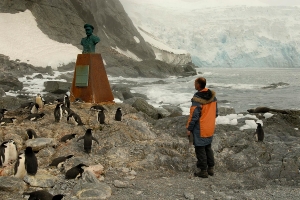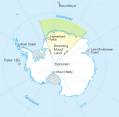Bar ShackletonToday it is one week since our aircraft was supposed to take off towards the south. We still don’t know how long we will be stuck in Punta Arenas. Yesterday we killed some time with a cup of coffee at Bar Shackleton.

The bar is in venerable surroundings, redolent with style and history. The walls are decorated with paintings that tell the story of one of polar history’s greatest dramas. Ernest Henry Shackleton is undoubtedly one of the greatest. He participated in the Discovery expedition (1901-03), led by Robert Scott. The relationship with the expedition leader became strained and Shackleton was sent home, humiliated, ostensibly because he had developed scurvy. But Shackleton would return with a vengeance. During the Nimrod expedition (1907-09) he was the first person to find a way up onto the Polar Plateau. With three of his men, he planted the British flag in the snow at 88° 23’ S, just 180 km from the South Pole. They had found the route Scott was to follow three years later. “But the greatest thing he did,” says the adventurer from Isfjorden contentedly, over a cup of good strong coffee, “was to rescue his men from Elephant Island. That has to be one of the most mind-boggling feats ever accomplished.” For the uninitiated, the polar historian recounts the story in a nutshell: Shackleton left London in 1914 with the ambitious goal of crossing Antarctica from the Weddell Sea, over the South Pole, to the Ross Sea. But his ship Endurance was entrapped in ice, crushed, and sank 27 October 1915. After a dramatic escape the crew came ashore at Elephant Island, at the northern end of the Antarctic Peninsula. They were on land, but it was no place to stay. And the likelihood of being found was essentially nil. Winter was taking its icy grip on the south, but Shackleton chose five men to accompany him in an attempt to sail one of the lifeboats over to South Georgia. After fifteen horrific days at sea, braving all the storms and hurricanes the Southern Ocean had to offer, incredibly, they made landfall on the tiny island 8 May 1916. Shackleton and his companions did not stop there, but went on for another 36 hours, climbing over a mountain, to reach the Norwegian whaling station Strømnes. And now Punta Arenas comes into the picture. After three unsuccessful attempts to reach Elephant Island in the winter (once with the Norwegian whaler Southern Sky), Shackleton came to this city and got hold of the Chilean ship Yelcho, and 30 August 1916 he could finally rescue his 22 crewmen, who had survived for four months living in an upside-down lifeboat. “Hmm,” says the skier, “just 180 kilometres from the finish line. Shackleton was practically at the South Pole. What would have happened if he had come home with the prize?” “Then Amundsen would have left the South Pole to its own devices and gone north to chart the Arctic Ocean,” says Jan-Gunnar immediately. “But what do you think, Harald Dag? Would Norwegians have taken any interest in a race in Antarctica if Shackleton had succeeded?” “Now that’s a good question. I doubt Prime Minister Jens Stoltenberg would be going to the South Pole on the fourteenth of December this year. And we wouldn’t be sitting around waiting in Punta Arenas.” Did you know that Dronning Maud Land was completely unexplored until just 80 years ago?
Dronning Maud Land is the Norwegian claim sector in Antarctica, annexed 14 January 1939. The area occupies one-sixth of the Antarctic continent and is almost seven times larger than Norway. It is named after Queen Maud of Norway (1869–1938). |
South Pole 1911–2011 is an informational outreach project run by the Norwegian Polar Institute
Contact person:


